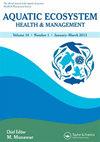底特律河关注地区的栖息地恢复
IF 0.8
4区 环境科学与生态学
Q4 ENVIRONMENTAL SCIENCES
引用次数: 10
摘要
鱼类和野生动物栖息地的丧失和退化是底特律河的一个长期问题。《底特律河修复行动计划》帮助各机构和利益相关者团体就受损的有益用途达成协议,包括鱼类和野生动物栖息地的丧失,并帮助动员所有利益相关者恢复栖息地。许多组织发挥了关键作用,包括底特律河公共咨询委员会、底特律河加拿大清理组织、海峡状况会议、美国和加拿大遗产河倡议、底特律河国际野生动物保护区和伊利西湖流域优先自然区。所取得的成就包括:在底特律河加拿大和美国一侧开展了14个栖息地恢复项目;流域软海岸线工程项目53个;河中有9个鱼类产卵暗礁,共有4处燕鸥栖息地;以及许多湿地和绿色基础设施项目。根据底特律河过去32年的栖息地恢复工作,提出了以下建议:就问题的严重性和地理范围达成一致;实行适应性管理;让栖息地专家提前参与项目设计;制定项目成功的量化目标;确保提供健全的多学科技术支持;从示范项目开始;将栖息地项目视为实验;让公民科学家参与监测;衡量效益;交流和庆祝成功;促进教育和外联。本文章由计算机程序翻译,如有差异,请以英文原文为准。
Habitat rehabilitation in the Detroit River Area of Concern
Loss and degradation of fish and wildlife habitat is a long-standing issue in the Detroit River. The Detroit River Remedial Action Plan helped agencies and stakeholder groups reach agreement on impaired beneficial uses, including loss of fish and wildlife habitat, and helped mobilize all stakeholders to rehabilitate habitat. Many organizations played key roles, including the Detroit River Public Advisory Council, Detroit River Canadian Cleanup, State of the Strait Conferences, American and Canadian Heritage River Initiatives, Detroit River International Wildlife Refuge, and Western Lake Erie Watersheds Priority Natural Area. Accomplishments include: 14 habitat restoration projects on both the Canadian and U.S. side of the Detroit River; 53 soft shoreline engineering projects in the watershed; nine fish spawning reefs in the river, Common Tern habitat in four locations; and many wetland and green infrastructure projects. Based on Detroit River habitat restoration efforts over the last 32 years, the following advice is offered: reach agreement on severity and geographic extent of the problem; practice adaptive management; involve habitat experts up front in project design; establish quantitative targets for project success; ensure sound multidisciplinary technical support; start with demonstration projects; treat habitat projects as experiments; involve citizen scientists in monitoring; measure benefits; communicate and celebrate successes; promote education and outreach.
求助全文
通过发布文献求助,成功后即可免费获取论文全文。
去求助
来源期刊

Aquatic Ecosystem Health & Management
环境科学-海洋与淡水生物学
CiteScore
1.70
自引率
0.00%
发文量
1
审稿时长
18-36 weeks
期刊介绍:
The journal publishes articles on the following themes and topics:
• Original articles focusing on ecosystem-based sciences, ecosystem health and management of marine and aquatic ecosystems
• Reviews, invited perspectives and keynote contributions from conferences
• Special issues on important emerging topics, themes, and ecosystems (climate change, invasive species, HABs, risk assessment, models)
 求助内容:
求助内容: 应助结果提醒方式:
应助结果提醒方式:


